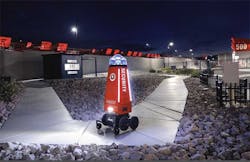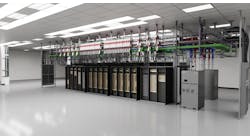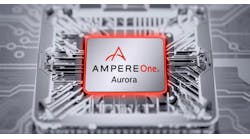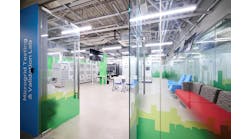There are always going to be humans involved in most data centers. But we are already seeing a disconnect between the enormous volume of servers and storage that must be managed, and the volume of skilled workers available to manage them.
Robotics will be part of the toolkit as the data center industry seeks to accelerate the automation of cloud. Social distancing during the COVID-19 pandemic also provides plenty of incentive for a broader use of robotics in data center management scenarios.
Technology infrastructure specialist Switch is on the forefront of this trend with the development of Switch Sentry security robots, which it plans to deploy at future edge data centers and will also sell to enterprise customers.
The robots are the latest high-tech innovation from Switch founder and CEO Rob Roy. The wheeled Switch Sentry units are nearly six feet tall, and designed to provide security for mission-critical facilities.
Switch says each Sentry is autonomous, with the ability to navigate on its own or be steered by a human. Each robot can be equipped with motion detection sensors, night vision and LIDAR (laser light detection sensors) and use 3D mapping to navigate its environment. On-board security features include facial recognition, temperature detection for fevers, and a bullet-resistant exterior for active shooter scenarios. Each unit is equipped with two-way voice and video communication, and can speak with either a male or female voice.
Switch first discussed its robotics offering in May. On the Switch earnings call last week, company officials said Switch Sentry will be a stand-alone product offered to enterprises.
“One of the concerns regarding edge deployment is physical security,” said Switch President Thomas Morton. “Deploying 24x7x365 human guards at edge locations isn’t economically or physically practical. To address this issue Rob Roy has developed a robotic AI human-in-the-loop security solution. In addition to the use at our own data center facilities, the excitement generated from these enterprise alpha test client partners has led to Switch offering the Switch Sentry Robot as a stand-alone security platform to the general market.”
The Next Frontier for Data Center Automation?
Switch is among the many players seeking to build edge computing infrastructure to bring data and compute power closer to end users, improving performance and enabling new latency-sensitive applications. The company’s edge data centers will extend the modular deployment approach employed in Switch’s Core and Prime data center campuses.
The Switch Sentry offering addresses a key challenge of edge computing – maintaining a distributed network of smaller computing facilities. Many edge computing companies are building unstaffed, highly-automated facilities. Robotics has emerged as one solution, and also may address concerns about workforce health during the COID-19 pandemic. In a contactless, socially distanced economy, robots will likely play a larger role.
The Switch Sentry is 70 inches high and 32 inches wide, and weighs about 250 pounds.
“We initially envisioned robotics as being augment to the security systems for Switch Edge,” said Morton. ” But we had so many customers asking us, ‘hey, can we deploy this at our facilities or at our industrial locations?’ As enterprises seek solutions for mission critical data storage, we believe there is an industry-wide deficiency in the physical security environment supporting hybrid cloud storage offerings. They are absolutely available to those who don’t have colocation with us, and can be deployed in non-colocation environments just as effectively as colocation facilities.”
Robots Add Density Option for Edge Deployments
Switch isn’t he only edge player looking at robotics as a component of their offering. Edge colocation provider DartPoints has partnered with cooling specialist TMGcore, which recently launched a data center enclosure that uses robots to swap high-density servers immersed in coolant fluid. It’s one of the most ambitious efforts yet to create a “lights out” autonomous data center.
TMGcore has developed robotics technology that can swap servers, removing a failed server from the immersion bath and replacing it with a fresh server. The immersion approach allows tenants to deploy extremely dense workloads in a small space, consolidating 600 kW of compute into an enclosure with a footprint of just 160 square feet,
“Partnering with DartPoints allows us deliver a turnkey solution, quickly, in edge markets, allowing customers to easily interconnect and distribute their content and applications,” said John David Enright, CEO of TMGcore. “These markets are eager to gain access to locally generated and consumed content and applications in a way that is optimized while remaining cost efficient.
One of the most interesting applications of robotics has been in interconnection. In Frankfurt the interconnection specialist DE-CIX created a robotic system which it named Patchy McPatchbot, which has automated the provisioning and upgrading of networks.
Data Center Frontier recently examined the future of robotics in data center management in a feature story and accompanying podcast). Visit our Robotics Channel for additional coverage.






